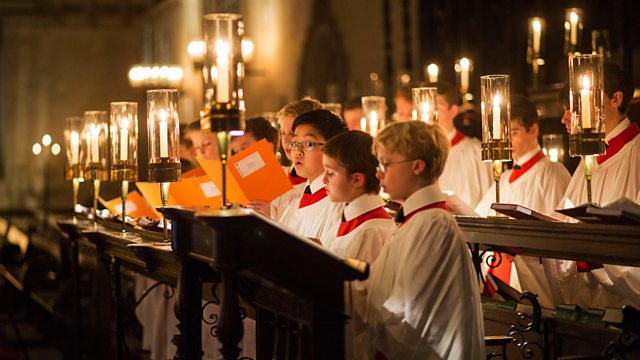Christmas, for many people, began at exactly 3 p.m today, Christmas Eve. The moment when everything stops, frantic present-wrapping, mince-pie making and tree-decorating ceases and calm briefly takes hold. The reason? A single boy treble whose voice, clear and fragile as glass, pierces through the chaos with those familiar words: ‘Once in Royal David’s city/ Stood a lowly cattle shed…’.
The service of Nine Lessons and Carols from King’s College, Cambridge, and its annual broadcast on BBC Radio 4 is as essential a part of contemporary Christmas folklore as stockings and Santa Claus, plum pudding and presents. Ageless and timeless, it seems as though there must always have been boys in red robes singing carols in a candlelit chapel — an ancient ritual renewed with each generation.
But the reality is quite different. The Festival of Nine Lessons and Carols was celebrated at King’s for the first time in 1918, not a historic service at all but an invented tradition — modern and man-made. And tempting though it is to imagine that this delicate fusion of words and music was created in the exquisite interior of King’s Chapel, the product of contemplation and beauty, its origins were in fact far less exalted: born in a wooden hut in Truro and conceived in the muddy, bloody trenches of the first world war, a child of horror and suffering, not peace and goodwill.
The story of Nine Lessons and Carols begins with an Anglican clergyman. Eric Milner-White was the ‘very shy, but tremendously kind’ young man appointed chaplain of King’s in 1912. Quick to volunteer when war broke out in 1914, he traded the quiet life of Cambridge for the squalor and violence of the French front line. Most of his letters home are gone, destroyed by Milner-White himself. But the few that remain paint a vivid picture of his experience, caught between banality (‘On days when too many tragedies aren’t happening there are many elements of the picnic about it’) and horror (‘Most of life is at night, and the nights are filled with prolonged terror — a horrid, weird, furtive existence’).
Returning to Cambridge in 1918 after ‘a battle of special horror’, Milner-White was appointed dean of King’s and immediately set about reforming a liturgy his experience convinced him was not just inadequate but irrelevant to the needs of a community so damaged and disillusioned. ‘Colour, warmth and delight’ were to be the focus, offering aesthetic as well as spiritual consolation in only the simplest and most direct language. Wanting to create a special service for Christmas, Milner-White took inspiration from Edward White Benson — the first bishop of the new diocese of Truro.
Created in 1876, the diocese had neither traditions nor a cathedral to house them in, so for seven years the congregation gathered in a temporary wooden hut, boasting neither ventilation nor heating. The context was a simple one, and Benson wanted a Christmas Eve service to match it — something that would serve, pragmatically, ‘…both as a counter-attraction to the public houses and as a right prelude to Christmas’. And so the service was born, a potent combination of ‘nine carols and nine tiny lessons’ that provided the structure still familiar to us today.
The hierarchy of readers — progressing up through the ecclesiastical ranks from a lowly chorister to the Bishop himself — was already there, as was the Biblical narrative, moving from Old Testament to New, from Creation to Incarnation. But it was Milner-White who found the simple essence of the service, cutting the more ponderous elements to reveal its emotional and spiritual core, speaking directly to those attending without the need for a mediating sermon.
What started out as a local phenomenon, a ‘gift to the city of Cambridge’, quickly became a gift to a much wider community. In 1928 the service was first broadcast by BBC Radio, and since 1938 the World Service has transmitted it to listeners across the world, with television broadcasts joining it annually from 1963. Such popularity could never have been imagined by Milner-White, but the enduring and widespread appeal speaks to this young man’s understanding of human nature. That the broadcasts persisted internationally throughout the second world war, not just in Allied but also occupied and even Axis nations, speaks loudly of the service’s power, and stories abound of British and American soldiers imprisoned in German and Japanese prisoner-of-war camps recreating the King’s service as best they could with makeshift instruments and robes.
The need for beauty, for simplicity and innocence is as great now as it ever was, and in a world of growing divisions, tensions and ever-escalating conflict we still find fulfilment in a service that stimulates but also consoles. So next time you turn on the radio and hear that lone chorister, or watch King’s candlelit choir on the television, remember that this is beauty born in blood, a cry for peace that was nearly drowned out in the noise of battle.






Comments